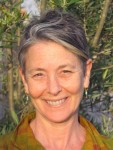Prejudice can be held toward the idea of ability and dance when envisioning a supposedly ideal body. This notion can be challenged by having individuals with disabilities present their own ways of expression and movements, said Victoria Marks.
The professor of choreography/performance and chair of the disability studies minor will co-lead the UCLA Disability Inclusion Lab’s DANCING DISABILITY at Glorya Kaufman Hall from June 23 to 29. The event features laboratories in which participants identifying with a disability choreograph their own movements, as well as seminars for the same individuals to discuss the aesthetics and issues surrounding disability.
Bringing awareness to the presence of people with disabilities in the dance field gives performers a chance to showcase diversity through choreography, Marks said.
“It’s not teaching somebody to do something that already exists, it’s creating an opportunity for these artists to make something of their very own with a set of languages and skill sets that … will be part of their art form,” Marks said.
The event will help dancers with disabilities feel justified and affirmed as creators of art, Marks said. Disability dance offers a new and different way of thinking and being in the world, said Emory University professor Rosemarie Garland-Thomson. While covering disability justice and accessible technology, Garland-Thomson said she will also feature the importance of accessible environments while leading the Critical Disability Studies Seminar portion of the event.
Communicating using visual images, an appropriate auditory environment and American Sign Language will also make the workshop a reflection of an inclusive and accessible environment, Garland-Thomson said. Her workshop will present performances of ASL poetry and blind burlesque, she said, to showcase aesthetic works from people with disabilities.
[RELATED: Class strips stigma from pole-dancing, trades fetishization for self-expression]
The concept of transformation helps correct disability injustice in the dance genre, Garland-Thomson said. One form of transformation is done through costuming, she said, where devices like crutches or wheelchairs are thought of as aesthetic implements rather than medical equipment. Transformation can also take the form of redefining the expected appearances of dancers themselves, Garland-Thomson said.
To accomplish this, Garland-Thomson said she will show participants images of dancers that have bodies different from “traditional” dancers – such as artists that do not have legs or have unusually shaped arms. She said disability dance challenges conceptions on what is classified as a “dancing body.”
“Disability dance puts forth a model of how bodies are understood generally (and) traditionally within culture and society as being damaged, limited (and) abnormal,” Garland-Thomson said. “It transforms those bodies … to enter into this visual economy as what counts as aesthetically beautiful (which) is a very important thing to do in terms of what we think of as inclusion or justice in the world.”
Participants will be able to attend laboratories such as the “Discovery Lab” and “Making Lab.” During the former, Marks said attendees will individually explore choreographic access to movement through their bodies. Alice Sheppard, a dancer and choreographer, said participants will be asked to research the cultural meanings of their physical impairments as a translation method to create movements that reflect their findings.
“The work is really focused through each individual impairment,” Sheppard said. “I will be supporting them as they … language their impairment and then think about the cultural values that are ascribed to that.”
[RELATED: LGBTQ dance group to raise awareness for AIDS in 26-hour Dance Marathon]
The “Making Lab” will present attendees with specific situations to solve, such as what “vitality” can look and feel like, Marks said. One of the situations attendees will be presented is how to create and thwart expectations, she said. Each person must individually find their own solution method, which she said demonstrates how individuals with disabilities can use their own movements instead of learning other people’s techniques to produce art.
People participating in the event come from a range of countries, including New Zealand and South Africa, which she said provides a wider variety of movements and cultural interpretations. Participants of the event will gain a greater sense of community with other international artists with disabilities – even when they return back to their hometowns, Marks said.
The event will assist with breaking down the notion that only one type of disability and body exists, Marks said, through encouraging artists to pursue their own artistic visions and embodiment in their local communities.
“Rather than present one normalized idea (of) what dance and disability could look like, what we are there to do is to encourage this group of artists to pursue their own vision and their own embodiment,” Marks said.
Bringing awareness to individuals with physical differences in the dance community provides an opportunity for them to express their own experiences to the public, Marks said.
“Every time we don’t encounter a person with physical differences, we continue to live in a world where we confirm the notion that bodies are normalized and typical,” Marks said. “Putting out in the world that there are communities of individuals who move differently is an opportunity for the rest of us to broaden our sense of who we … are.”
